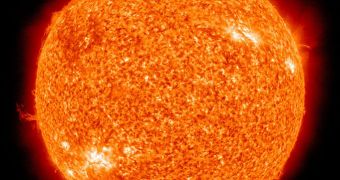While conducting routine observations of the Sun, the NASA Solar Dynamics Observatory (SDO) saw a medium-class solar flare on June 7. While there is nothing unusual about this event itself, what puzzled solar physicists was the massive tsunami that rippled on the surface of the star.
As viewed by the SDO, the consequence of the event only registered as an M on the Richter scale of solar flares, but the effects that this solar storm had on the surface of the star was puzzling to say the least. However, this only became apparent when experts studied the videos SDO sent back.
The 13 MB movie was collected in ultraviolet wavelengths, and it revealed that magnetic filament that triggered the entire event. Although it only produced a normal flare, the explosion also spread out solar material all over the place, so much so that researchers believed half of the star was coming loose.
The ripples and dark blobs that ensued after the flare was released spread over massive distances, covering about half of the entire solar surface Solar physicists say that this is the first time such dire fireworks are seen dotting the Sun's face, Daily Galaxy reports.
“We'd never seen anything like it. Half of the Sun appeared to be blowing itself to bits,” says solar physicist Alex Young, who holds an appointment at the Greenbelt, Maryland-based NASA Goddard Space Flight Center (GSFC).
“In terms of raw power, this really was just a medium-sized eruption, but it had a uniquely dramatic appearance caused by all the inky-dark material. We don't usually see that,” the expert goes on to say.
“The blast was triggered by an unstable magnetic filament near the Sun's surface. That filament was loaded down with plasma, which exploded in a spray of dark blobs and streamers,” adds expert Angelos Vourlidas.
He holds an appointment as a solar physicist at the Washington, DC-based Naval Research Laboratory (NRL). Many of the dark blobs that were produced were even larger than Earth, while some were a bit smaller. When falling back onto the solar surface, they exploded like bombs.
Other blobs were snatched by powerful magnetic field lines, and then guided to sunspot groups located several hundreds of thousands of kilometers away, Young notes. He adds that the solar tsunami which accompanied the rupture of the magnetic filament spread halfway around the Sun.
“The June 7 blast didn't seem to trigger any big secondary explosions, but it was certainly felt far and wide,” Young explains. “The blast also propelled a significant coronal mass ejection (CME) out of the sun's atmosphere,” Vourlidas concludes.
Video credit: NASA / SDO
 14 DAY TRIAL //
14 DAY TRIAL //